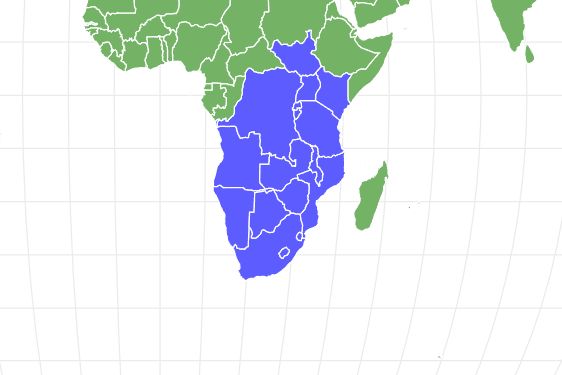White Rhinoceros
Ceratotherium simum
The second largest animal on the land!
Advertisement
White Rhinoceros Scientific Classification
- Kingdom
- Animalia
- Phylum
- Chordata
- Class
- Mammalia
- Order
- Perissodactyla
- Family
- Rhinocerotidae
- Genus
- Ceratotherium
- Scientific Name
- Ceratotherium simum
Read our Complete Guide to Classification of Animals.
White Rhinoceros Conservation Status
White Rhinoceros Facts
- Main Prey
- Grass, Fruit, Berries, Leaves
- Habitat
- Tropical bushland, grassland and savannas
- Predators
- Human, Wild cats
- Diet
- Herbivore
- Average Litter Size
- 1
View all of the White Rhinoceros images!
“The largest of all rhino species”
Known for its square upper lip, large two horns, and incredible size, the white rhino once roamed across southern and northern Africa.
At the start of the 20th century, the white rhino population dwindled to as few as 50 individuals. Today, the white rhino shows both the promise of conservation for the species and the incredible threats still facing it. While the Southern white rhino has seen its population rebound so strongly that it’s no longer endangered, the Northern white rhino is now functionally extinct with just two females remaining.
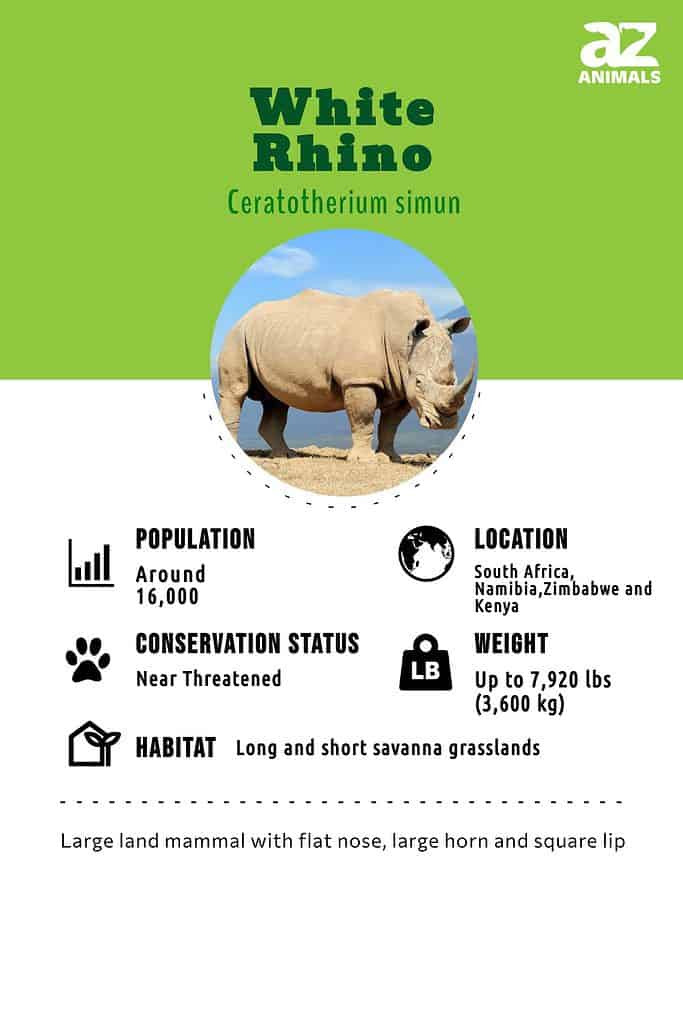
Incredible White Rhino Facts!
- Incredibly fast charging speed: The white rhino’s top speed can exceed 30 miles per hour (48 km/h)!
- Recently extinct subspecies: In 2018, the Northern white rhino was declared functionally extinct when the last male passed away.
- Record size horns: White rhino horns can reach up to 150 cm (59 inches)!
Scientific Name
The white rhino’s scientific name is Ceratotherium simun. The word “Ceratotherium” is derived from the Greek words for “horn” and “beast” while “simun” is Greek for a flat nose.
As their signature feature, the scientific name of every rhino species references their “horn.” However, the white rhino is the only species whose scientific name references a flat nose.
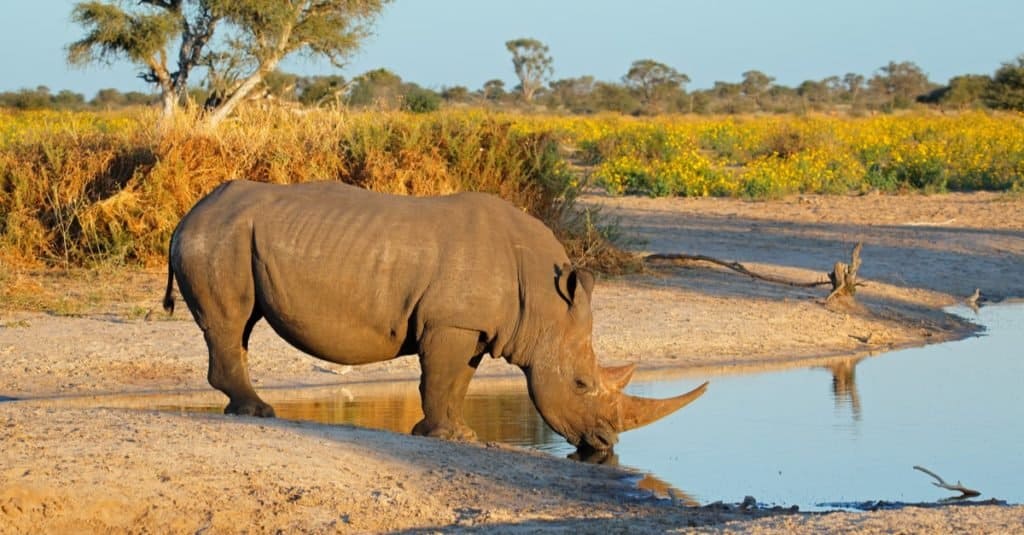
When comparing white rhinos to the other species that live across Africa – the black rhino – the white rhino’s mouth is square while black rhinos have a more triangular mouth.
©EcoPrint/Shutterstock.com
Appearance
If you’re looking at the rhino pictures on this page, you’ve noticed the species is actually grayer.
That’s because the name “white rhino” actually comes from a mistranslation! Dutch settlers in South Africa began calling the species the “weit” rhino, which is the Afrikaans’ word for “wide.” The description applied to the white rhino’s unique square mouth.
However, English settlers mistranslated the name, instead calling the species the “white rhino!”
When comparing white rhinos to the other species that live across Africa – the black rhino – the white rhino’s mouth is square while black rhinos have a more triangular mouth.
The white rhino has a number of distinct physical characteristics such as the large “hump” across its back. This hump is a muscle mass that’s evolved to support the species’ massive head. Another key defining feature of white rhinos is their size, which is the largest among rhino species.

An illustration of the extinct Woolly Rhinoceros slowly making his way through an Ice Age forest. The woolly rhinoceros was a member of the Pleistocene megafauna, common throughout Europe.
©Aunt Spray/Shutterstock.com
Evolution
The rhino family is believed to have diverged from the Tapir family 55-60 million years ago. Over a hundred species spread all across the earth – with nine surviving to the late Pleistocene Age ( 14 to 12,000 years ago). Subsequent extinctions left five species – the black, white, Sumatran, Indian, and Javan. There are also four extinct species – the Siberian, Merck, narrow-nosed and wooly rhinoceros.
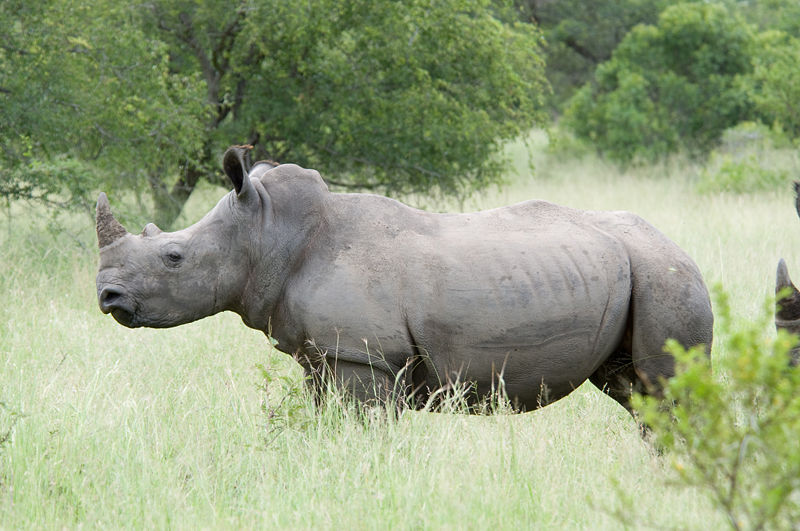
Weight
The white rhino can weigh up to 3,600 kg (7,920 pounds), making it the second largest land animal on earth after the elephant!
White rhinos are large from birth, a baby recently born at the San Diego Zoo exceeded the size of a fully grown adult human just 19 days after birth when it weighed in at 193 pounds (87 kg).
Males can grow significantly larger than females, reaching a top weight of nearly 4 tonnes. Females are generally significantly smaller, weighing on average about ¾ the weight of a male when fully grown.
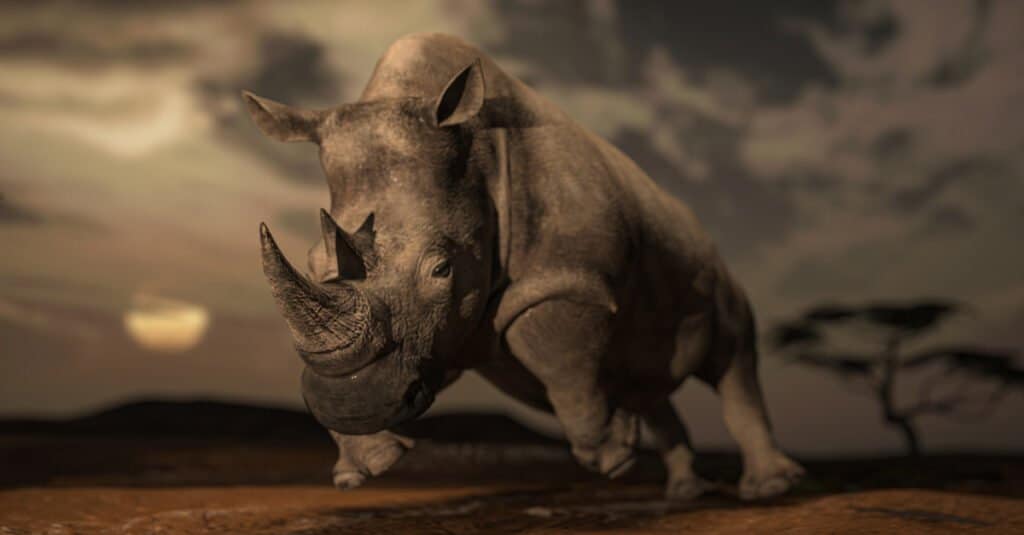
The white rhino can reach speeds that exceed 30 miles per hour.
©bekirevren/Shutterstock.com
Top Speed
For such a large species, the white rhino has incredible acceleration and can reach speeds that exceed 30 miles per hour (about 48 kilometers per hour).
For comparison, the world’s fastest-recorded human was Usain Bolt, who hit 27 miles per hour! The top speed of white rhinos also exceeds that of other large African land mammals such as elephants or hippos.
Why do rhinos charge? The species has evolved excellent hearing and smell, but its vision is reportedly very poor and near-sighted. Charging allows rhinos to defend themselves against unfamiliar objects. It can be very common for mothers to defend calves, and males to defend their territory.
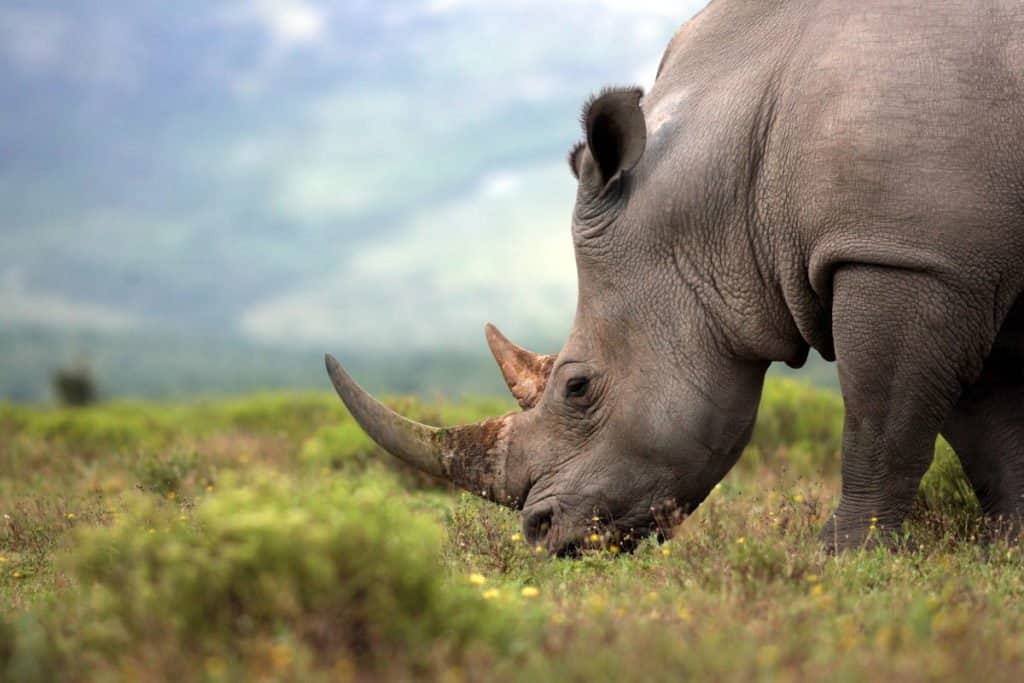
White rhino horns are typically about 35 inches long but have been known to grow to 59 inches.
©JONATHAN PLEDGER/Shutterstock.com
White Rhino horn
White rhino horn can grow to the largest sizes among all rhino species. In a 2006 study, Dr. Nico van Stein measured a 150 cm (59 inch) white rhino horn!
The larger of the white rhino’s two horns typically is about 90 cm (35 inches) in length while the second horn is smaller and typically does not exceed 60 cm (24 inches).
Unlike other species whose horns or antlers are attached to their skull, rhino horns are made of keratin, a material you’ll also find in your fingernails! This also means that if rhino horns are cut off (without cutting into their skull) they can grow back within about three years.
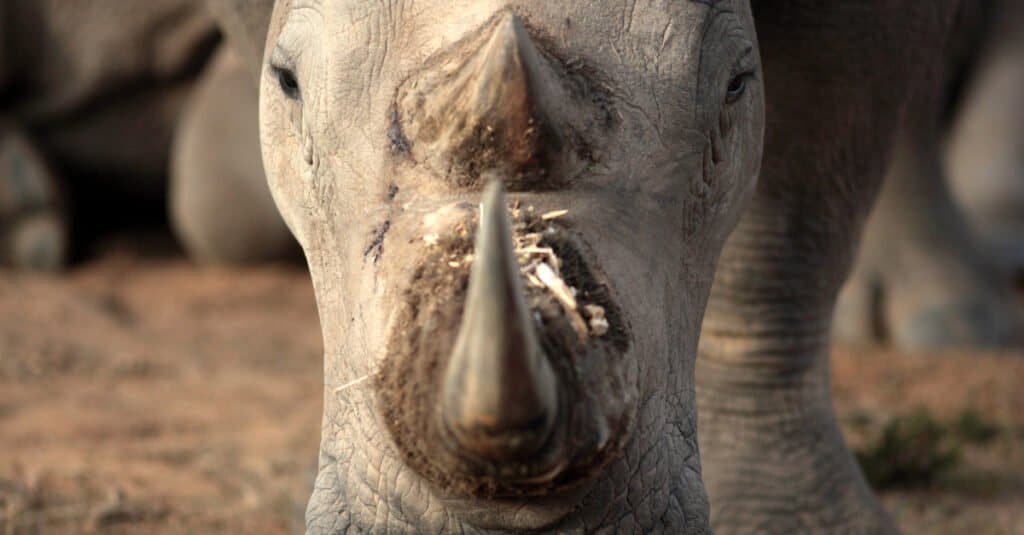
Unlike other species whose horns or antlers are attached to their skull, rhino horns are made of keratin, a material you’ll also find in your fingernails.
©JONATHAN PLEDGER/Shutterstock.com
Two Subspecies of White Rhino
There are two subspecies of white rhino, the Northern and Southern. The main difference between the two is size. Northern white rhinos are smaller. Their head, horn, width, and length are all smaller than southern white rhinos. On average, northern white rhinos are 2/3 the weight of fully grown southern white rhinos.
In addition, Northern white rhinos have a flatter back, lacking the very pronounced “hump” found on most Southern white rhinos.
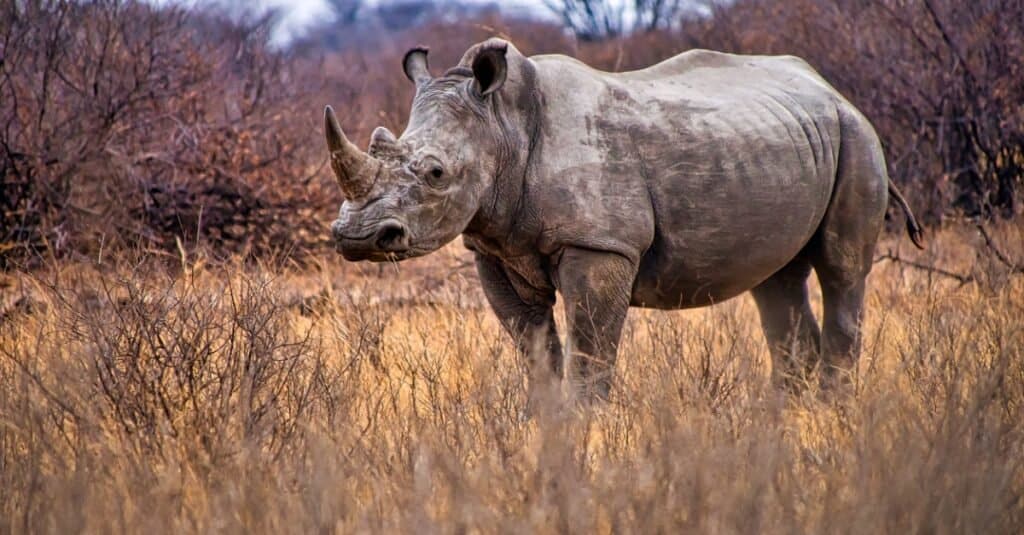
White rhinos live in grasslands that can support their massive grass consumption – 120 pounds per day.
©iStock.com/Alberto Carrera
Habitat
White rhinos are one of two rhino species that live across Africa. Their preferred habitat is large grasslands, though increasingly their population is concentrated in nature reserves where they can be protected.
The Northern white rhinoceros range once spanned across South Sudan, the Democratic Republic of the Congo, the Central African Republic, and Uganda. However, poaching dramatically reduced the range of Northern White Rhinos. Today, Northern white rhinos are extinct in the wild aside from the two remaining females that have been introduced into Ol Pajeta Conservancy in Kenya.
The Southern white rhinoceros historically ranged from South Africa to Botswana, Namibia, Zimbabwe, and other neighboring countries. Today, their population is concentrated in a number of national parks such as Kruger national park, where an estimated 8,000 to 9,000 white rhinos live in a single nature preserve.
Population — How Many White Rhinos Are Left?
As of 2022, it was estimated that are about 16,000 white rhinos living in the wild. In the early 20th century the white rhino population numbered as few as 50 individuals so this rebound has been an incredible conservation success story. However, white rhinos today remain under threat.
Precise estimates of White rhino populations are difficult because of the high rates of poaching. It is estimated that more than 80% of the African rhino population lives in South Africa, and as you can see from the chart below, poaching has significantly escalated in recent years:
South African Poaching Deaths From the Year 2007 to 2018
| 2007 | 13 |
| 2008 | 83 |
| 2009 | 122 |
| 2010 | 333 |
| 2011 | 448 |
| 2012 | 668 |
| 2013 | 1,004 |
| 2014 | 1,215 |
| 2015 | 1,175 |
| 2016 | 1,054 |
| 2017 | 1,028 |
| 2018 | 769 |
While the Southern white rhino has seen its population rebound, the Northern white rhino is a different story. Its populations never rebounded from early 20th-century poaching and in March 2018 the last surviving male white rhino died, leaving a population of just two females remaining.
Predators
As the largest of the rhino species, white rhinos face few predators. Babies face threats from lions, crocodiles, and other larger carnivores like big cats, hyenas, and wild dogs.
Adult white rhinos face few threats from predators. The species not only possesses long horns and high top speeds but also has a thick skin that serves as a form of “natural body armor.” This provides an additional form of protection from larger predators like lions.
The top predator of rhinos remains humans. Poaching deaths in South Africa reached a peak of 1,215 rhinos in 2014 and have since fallen, but remain substantially higher than in last decades. Most rhinos live on either private reserves or natural parks where they’re actively protected by armed guards and security.

Unlike their black rhino cousins, white rhinos’ diet consists of only grasses due to the square shape of their jaws.
Diet
White Rhinos live on vast savannas that are best suited to their diet of grasses. What white rhinos eat differs from the other African rhino species, the black rhino. While black rhinos have triangular-shaped mouth that allows them to eat vegetation from trees and bushes, white rhinos keep their grazing to the ground. The distinctive feature that gave white rhinos their name—their wide, squared-shaped mouth – is an evolutionary adaption to allow them to graze incredible amounts of grass each day.
Due to their massive size, white rhinos must consume more than 120 pounds of grass each day!
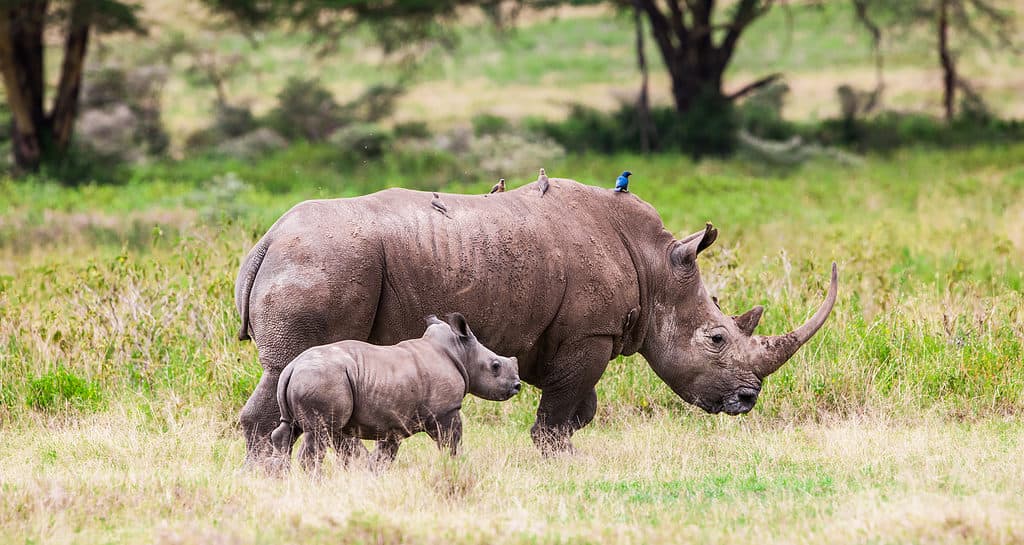
White rhinos have one of the longest gestation periods of all animal species at about 500 days.
©Travel Stock/Shutterstock.com
Reproduction and Life Cycles
White rhinos have one of the longest gestation periods of all animal species at about 500 days. This long gestation period follows a pattern where larger mammal species have longer development periods before birth.
- African Elephant: 645 days
- White Rhino: 500 days
- Giraffe: 430 days
- Human 270 days
- Bear (grizzly): 215 days
After giving birth, white rhinos typically don’t give birth again for an additional 3 to 4 years. This long gestation period and extended length between birthing new calves have made repopulating rhinoceroses an especially challenging problem.
How long do white rhinos live? The oldest white rhino in captivity died on November 14, 2018, at the age of 55. Life expectancy in the wild can reach 50 years, though as rhinos suffer from skin and digestive tract ailments as they age.
In Zoos
As of December 2018, there were 302 zoos with 1,037 rhinos. The white rhino is the most common rhino found in zoos, with a population of 671 white rhinos across the world.
Select zoos where you can see a white rhino in person!
- Maryland Zoo: A white rhino named Stubby.
- San Diego Zoo: More than 90 calves born in this zoo alone!
- Nashville Zoo: As of February 2019, four females and one male.
- Indianapolis Zoo: White rhinos are part of their plains exhibition.
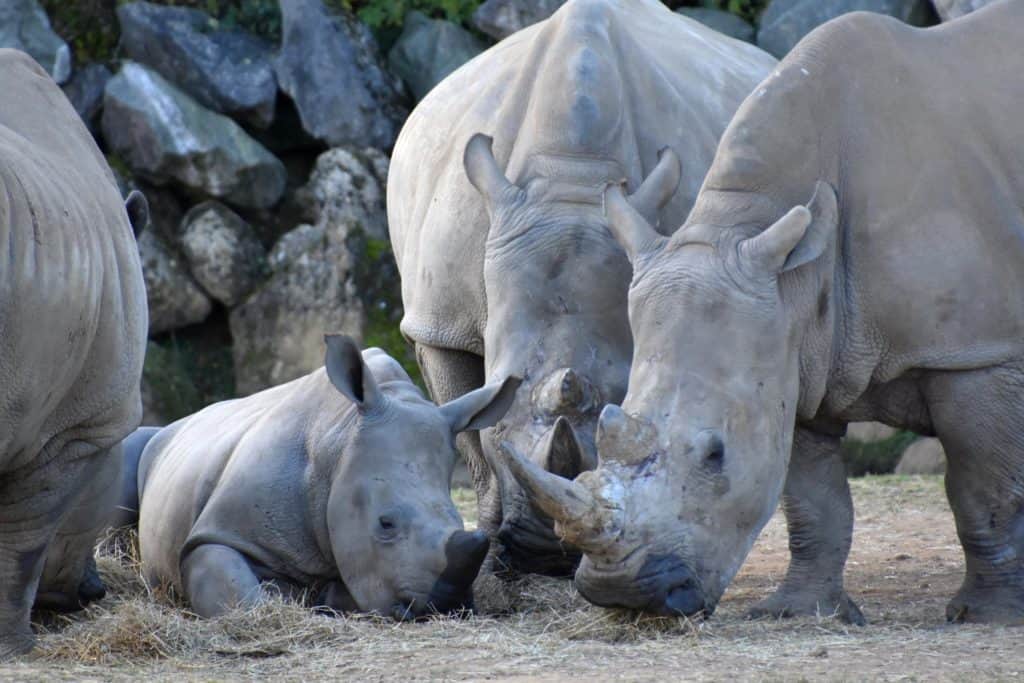
A crash of Rhinoceros (Rhinocerotidae) at Colchester Zoo, UK.
©Millie Bond – Copyright A-Z Animals
White Rhino Facts
- What is a group of rhinos called?
- Groups of bees are called swarms. A group of camels is a caravan. And the unique name for a group of rhinoceroses is “crash!”
- The last male Northern white rhino has passed away
- The last male Northern white rhinoceros died in captivity at a conservatory it’d been introduced into in Kenya on March 19, 2018. The loss of the last male makes Northern white rhinoceroses functionally extinct, although two females remain.
- Armed security to protect the last Northern white rhinos
- The last two remaining female Northern white rhinoceroses are protected around the clock by armed security.
- A new rhino species?
- The white rhinoceros could actually be two different species! A recent study from 2010 concluded that the Northern white rhino was actually a sixth rhino species rather than a subspecies of white rhino. This study isn’t universally accepted but makes the passing of the last male Northern white rhino especially saddening.
- The Southern white rhino is one of only two rhino species that’s not critically endangered
- Thanks to populations that have rebounded to an estimated 18,000 individuals, the white rhino today is listed as “Near Threatened.” The Indian rhino is listed as “Vulnerable” while the three other rhino species (black, Javan, and Sumatran) are all currently critically endangered.
- The white rhino is considered one of the “African Big Five.”
Frequently Asked Questions (FAQs)
Are white rhinos endangered?
As a species, the white rhino is no longer endangered. Today its status is listed as ‘Near Threatened.’ This conservation status of the white rhino is no longer being endangered due to the population increase. Today, more than 2/3 of rhinos across the world are white rhinos. However, while the species as a whole is no longer endangered, the Northern white rhino subspecies is listed as “Critically endangered.” With the last male Northern white rhino having passed away in 2018, the species is now functionally extinct.
While the Southern white rhino has seen its population rebound, the Northern white rhino is a different story. Its populations never rebounded from early 20th-century poaching and in March 2018 the last surviving male white rhino died, leaving a population of just two females remaining.
Similar Animals
View all 108 animals that start with WWhite Rhinoceros FAQs (Frequently Asked Questions)
Are White Rhinoceroses herbivores, carnivores, or omnivores?
White Rhinoceroses are Herbivores, meaning they eat plants.
What Kingdom do White Rhinoceroses belong to?
White Rhinoceroses belong to the Kingdom Animalia.
What phylum do White Rhinoceroses belong to?
White Rhinoceroses belong to the phylum Chordata.
What class do White Rhinoceroses belong to?
White Rhinoceroses belong to the class Mammalia.
What family do White Rhinoceroses belong to?
White Rhinoceroses belong to the family Rhinocerotidae.
What order do White Rhinoceroses belong to?
White Rhinoceroses belong to the order Perissodactyla.
What genus do White Rhinoceroses belong to?
White Rhinoceroses belong to the genus Ceratotherium.
What type of covering do White Rhinoceroses have?
White Rhinoceroses are covered in Leathery skin.
In what type of habitat do White Rhinoceroses live?
White Rhinoceroses live in tropical bushland, grasslands, and savannas.
What do White Rhinoceroses eat?
White Rhinoceroses eat grass, fruit, berries, and leaves.
What are some predators of White Rhinoceroses?
Predators of White Rhinoceroses include humans and wild cats.
How many babies do White Rhinoceroses have?
The average number of babies a White Rhinoceros has is 1.
What is an interesting fact about White Rhinoceroses?
The White Rhinoceros is the second largest animal on land!
What is the scientific name for the White Rhinoceros?
The scientific name for the White Rhinoceros is Ceratotherium simum.
What is the lifespan of a White Rhinoceros?
White Rhinoceroses can live for 45 to 50 years.
How fast is a White Rhinoceros?
A White Rhinoceros can travel at speeds of up to 30 miles per hour.
Thank you for reading! Have some feedback for us? Contact the AZ Animals editorial team.
Sources
- David Burnie, Dorling Kindersley (2011) Animal, The Definitive Visual Guide To The World's Wildlife
- Tom Jackson, Lorenz Books (2007) The World Encyclopedia Of Animals
- David Burnie, Kingfisher (2011) The Kingfisher Animal Encyclopedia
- Richard Mackay, University of California Press (2009) The Atlas Of Endangered Species
- David Burnie, Dorling Kindersley (2008) Illustrated Encyclopedia Of Animals
- Dorling Kindersley (2006) Dorling Kindersley Encyclopedia Of Animals
- David W. Macdonald, Oxford University Press (2010) The Encyclopedia Of Mammals

